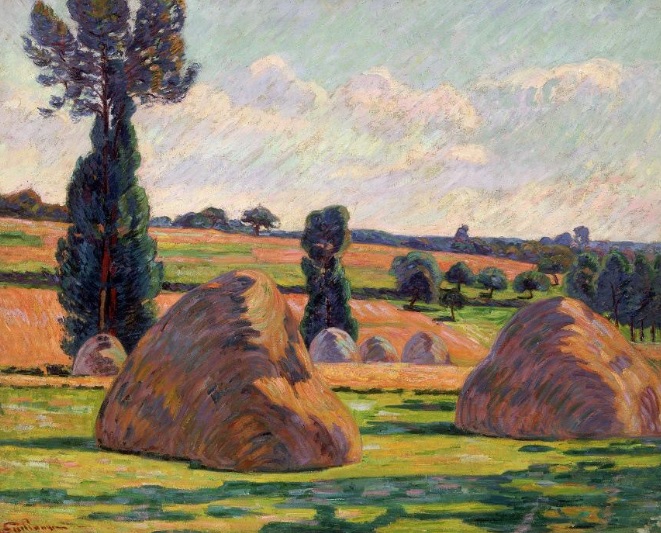
Armand Guillaumin
French, 1841-1927
Haystacks (Les Meules), 1894 ca.
oil on canvas
35 x 41 x 3 ¼ in.
SBMA, Gift of Dwight and Winifred Vedder
2006.54.7

J.K. Huysmans, in a review of the Impressionist exhibition of 1881, identified the distinctive qualities of Guillaumin that one can see are still evident in this later work: "Guillaumin, too, is a colorist, and what is more, a ferocious one. At first sight his canvases are a confusion of battling tones and rough contours, a cluster of vermillion and Prussian blue zebra-stripes. Step back and blink and everything falls into place; the planes become steady, and the strident tones calm. The hostile colors reconcile themselves, and you are astonished by the unexpected delicacy of certain parts of these paintings."
COMMENTS
Guillaumin began his art studies at Moulins where his family had settled shortly after his birth. At age 16 he went to Paris where he worked as a clerk and enrolled in a municipal art school. By 1859 he had a painting selected by the Salon. In 1860 and 1861 he studied at the Academic Suisse where he met Pissarro and Cezanne, who were to remain lifelong friends. They, in turn, introduced him to other young artists Bazille and Monet and the writer Emile Zola. Thus, in 1874 Guillaumin participated in the first independent public exhibition of the painters who were to be labeled the Impressionists. The following year he lived near Cezanne on the Quai d’Anjou and the two often painted together along the Seine. 1 While maintaining his ties to the Impressionist circle, Guillaumin also chose in 1884 to exhibit with the younger group of artists led by Signac and Seurat. In 1891 he won a city lottery of 100,000 francs, which enabled him to give up his administrative post and devote himself full time to exploring and painting depictions not only of the environs of Paris, but also the sea coast and a variety of rural settings.
The grain stacks, which are generally called ‘haystacks’ in English and ‘meules’ in French, were a frequent subject of the Impressionist painters in their careful scrutiny of the countryside. Monet, who had already painted them as early as 1883-84, made grain stacks the focus of a concentrated series in 1889-90 that he exhibited in Paris in May 1891. 2 Guillaumin, too, had painted a scene of haystacks covered by snow in 1883. 3 He did several more between 1889 and 1891, 4 and continued to feature them prominently in a number of his later prints. 5
Bibliography:
Santa Barbara Collects/Impressions of France, Eric Zaphran, SBMA 1998, p. 66.
References
1. Rewald, John ”Cezanne and Guillaumin,” in Studies in Impressionism (New York, 1984), 103-119.
2. Moffett, Charles S., “Monet’s Haystacks,” Aspects of Monet , eds. John Rewald and Frances Witzenhoffer (New York, 1984), 142-143.
3. Armand Guillaumin 1841-1927, exh.cat., Fondation de l’Herritage (Lausanne, 1996) no. 17.
4. Ibid., no. 42; G. Serrer and D. Fabiani, Armand Guillaumin 1841-1927, Catalogue raisonne de l oeuvre peint, (Paris, 1971), nos. 195-197; and a painting sold at Hotel Drouot, Paris, 9 March 1944, lot 26, and sold again at Sotheby’s, New York, 6 November, 1981, lot 330.
5. Lausanne exh.cat, 1996, nos. E22-24.
- Huysmans, J.K., “L’Exposition des independents", 1881, L’art modern (Paris, 1883), 236-237.
Prepared by Loree Gold for SBMA Docent Council, 2007.
SBMA CURATORIAL LABELS
Guillaumin exhibited at the first Impressionist exhibition in 1874 and continued to be one of the most interesting members of the Impressionist group. His paintings of grain stacks, generally called haystacks, were made at the same time as Monet’s, in 1890.
As early as 1881 a reviewer called Guillaumin “a ferocious colorist.” In this painting, the broad brushstrokes of bold color are already moving away from Impressionism and toward the future—foreshadowing the expressionistic use of color by artists such as Gauguin, van Gogh, and even Matisse.
- Ridley-Tree Reinstallation, 2022
